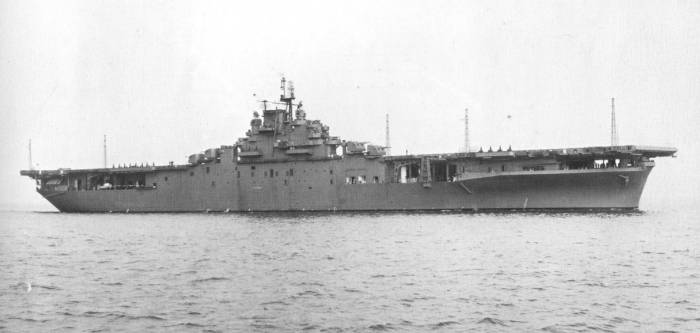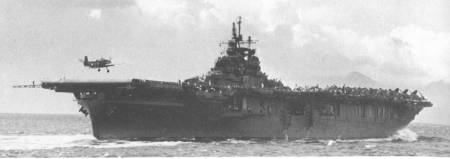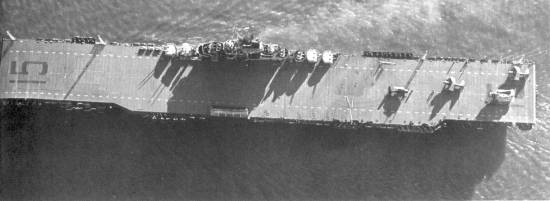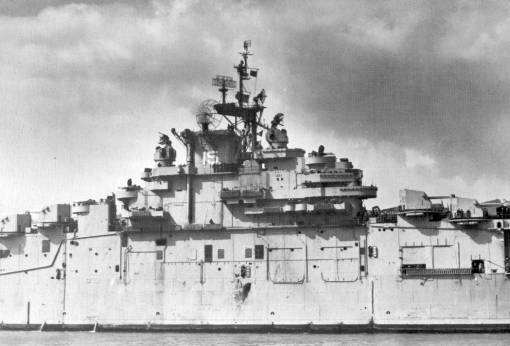

Design History
The Essex class, of which more ships were produced than of any other fleet carrier class, is the symbol of American carrier power in World War II. Its numbers alone would probably suffice to guarantee it a prominent place among the fleet carrier designs produced during the war, but another fact helps greatly: it was probably the best, and certainly the most successful, of World War II carriers.
The Essex class is another example of the American decision, made in 1940, to emphasize evolution of older designs over a completely new design in the face of the ever-worsening crisis in the world. Their evolutionary forebearers were the Yorktown class, and especially Hornet. Their potential lay in the fact that the Washington Treaty’s lapse in 1936 allowed for an increase in overall carrier tonnage to the levels for which the Fleet Expansion Act of 1938 provided. Since making more carriers available became an issue of utmost concern to the Navy, the Essex class was a mixture of new and old; employing construction techniques that were halfway between those designs which were already being build or had been completed, and those which were to be produced later (such as the huge Midway class).
Planning for the first ship, Essex, began in 1939, for Financial Year 1941, to absorb tonnage still available from the May 17th, 1938, expansion program to the Vinson-Trammell Act of 1938, which had already provided for Hornet. Leaving 20,000tons of tonnage, that expansion program had enough potential for another carrier of the size of Yorktown, yet to have somewhat different characteristics. Aircraft size had increased since the design of Yorktown, and that class had proven to be incapable of handling their designed 90 plane air group.
The new design was to have enough room on the flight deck to handle 90 larger planes, for a full deckload strike. To be able to provide this amount of deck space on a 20.000 displacement, a juggling act with the necessary above-deck structures had to be done. The first step involved the elimination of the starboard deck edge 5” guns, including the galleries, sparing the cut outs of the flight deck. Instead of those, four twin 5”/38 guns would be mounted, two each in front and abaft the bridge, superfiring. Together with the four remaining deck-edge guns on the port side of the ship, these guns would form the main defense of the ship. In addition, the Yorktown class‘ automatic weapons outfit would be retained.
 A score of demands was made for the new carrier to fulfill. It was to be able to steam astern for a considerable time for double-ended flight operations, and to be able to operate a
74-plane deckload launch without problems, all the time not sacrificing any of the Yorktown class‘ characteristics. That meant, with the added weight and space of the machinery,
and increase in the air group, an overall increase in the size of the ship far beyond the limited 20,400 ton which would have been available under ordinary circumstances. However,
during the design process, the outbreak of World War II in Europe allowed the designers to increase the size of their ship by almost 7000tons, to 27,100 tons in the final design.
This allowed for the measurable increase in fighting power that Essex had over Yorktown.
A score of demands was made for the new carrier to fulfill. It was to be able to steam astern for a considerable time for double-ended flight operations, and to be able to operate a
74-plane deckload launch without problems, all the time not sacrificing any of the Yorktown class‘ characteristics. That meant, with the added weight and space of the machinery,
and increase in the air group, an overall increase in the size of the ship far beyond the limited 20,400 ton which would have been available under ordinary circumstances. However,
during the design process, the outbreak of World War II in Europe allowed the designers to increase the size of their ship by almost 7000tons, to 27,100 tons in the final design.
This allowed for the measurable increase in fighting power that Essex had over Yorktown.
Different modifications were proposed to the armor and torpedo defense layout of the new ship; different propulsion methods were explored, including various armored decks and turbo-electric propulsion, already fitted in the Lexington class. In July 1939, two initial proposals were forwarded on the basis of 20,400 tons, the first a remodeled Hornet, the second an armored deck carrier. After further modification, the remodeled Hornet turned out to be almost Hornet herself, with the armored deck carrier being ignored.
The new carrier would have a 150,000shp engine, consisting of two of the plants used in the Atlanta class cruisers, and no turbo-electric propulsion was considered at this point anymore. Engine and boiler rooms alternated, and the there was considerable torpedo protection around the ship. The price for this, 24,250 tons standard displacement, was quite acceptable given the raising of individual ship limitations.
 By late autumn of 1939, the new design had quite distanced itself from Hornet by another decision: an armored hangar deck would be provided to keep bombs and shells out of the ships‘ vitals.
It would be formed by a 100-lbs hangar deck and a 60-lbs fourth deck, for a compromise of protection against bombs and 6” shellfire. This design was accepted by the Secretary of the Navy on
February 21st, 1940. It featured, in addition to the above characteristics, an overall shorter and smaller island, allowing for more deck space to park planes on, and a hangar-deck athwardships catapult.
It housed a full deck between the flight and hangar decks, utilized for aircrew ready rooms and later, a CIC (originally in the island), offered protection against 6” shell fire over a 7,500 yards
immunity zone, two aircraft catapults on the flight deck, and three elevators.
By late autumn of 1939, the new design had quite distanced itself from Hornet by another decision: an armored hangar deck would be provided to keep bombs and shells out of the ships‘ vitals.
It would be formed by a 100-lbs hangar deck and a 60-lbs fourth deck, for a compromise of protection against bombs and 6” shellfire. This design was accepted by the Secretary of the Navy on
February 21st, 1940. It featured, in addition to the above characteristics, an overall shorter and smaller island, allowing for more deck space to park planes on, and a hangar-deck athwardships catapult.
It housed a full deck between the flight and hangar decks, utilized for aircrew ready rooms and later, a CIC (originally in the island), offered protection against 6” shell fire over a 7,500 yards
immunity zone, two aircraft catapults on the flight deck, and three elevators.
In August, the arrangement plans showed alterations. The flight deck had been enlarged, simply by overhanging it farther than originally envisaged. A heavier catapult was required, leaving only one available for the same weight.
By December 1940, the amidships elevator, which had proven troublesome to design and fit, was replaced by a deck-edge unit, a full-capacity unit quite unlike Wasp’s but inspired by it. Finally, an increase in the air group to 88 and an increase in the 1.1” artillery to six mounts increased weight, but was accepted by the design.
Modification History
In early 1943, the fleet’s demands for more anti-air weaponry and better control for it lead to a redesign of the class. The flight-deck was shortened fore and aft, and the bow altered to
provide for a second quadruple 40mm mount atop of it, with another on the stern. A Mk37 director would be mounted on her port side below a flight-deck indention. The hangar-deck
catapult was removed in favor of another flight-deck unit, the CIC and fighter-direction office moved under armor cover. Several ships already under construction were altered to follow
this new (“long-hull”) design: CV-14, -15, -19, -21, -32, -36, -37, -39, -40, -45, -47. Not all modifications were made to all these carriers, but all had the shorter flight-deck.
 Among the more important modifications made to all ships of the class was the fitting of radar, for which the class was not originally designed. However, all ships were provided
with elaborate radar facilities, even though the lack of consideration for the necessities of radar caused undue doubling of efforts, such as the installation of two SG radars
to cover all arcs, and the necessity to sponsoon out several radars on makeshift platforms. All carriers received, in due course, SK air-search and SM height-finding radars,
SG surface-search sets, and various electronic jamming and homing devices, such as TDY jammers. In most cases SC-type air-search radars were installed as back-ups, and late
in the war, gunnery control radar sets were provided for the directors.
Among the more important modifications made to all ships of the class was the fitting of radar, for which the class was not originally designed. However, all ships were provided
with elaborate radar facilities, even though the lack of consideration for the necessities of radar caused undue doubling of efforts, such as the installation of two SG radars
to cover all arcs, and the necessity to sponsoon out several radars on makeshift platforms. All carriers received, in due course, SK air-search and SM height-finding radars,
SG surface-search sets, and various electronic jamming and homing devices, such as TDY jammers. In most cases SC-type air-search radars were installed as back-ups, and late
in the war, gunnery control radar sets were provided for the directors.
Service
Although ordered in 1940 for completion in March 1944, Essex herself commissioned on December 31st, 1942, fifteen months ahead of schedule. She set a precedent
followed by most Essex class ships, many of which completed well ahead of their scheduled completion dates. A total of 22 Essex class vessels were build, 17 of which
commissioned before the end of World War II and fourteen of which participated in combat operations.
Essex class carriers operated in all fast carrier operations starting with the November 1943 raids on Rabaul, the Gilberts-Marshalls operations, the Marianas and Carolines campaigns, the Philippine invasions and the operations around Iwo Jima and Okinawa. The large number of carriers makes it impossible to trace the service records of each ship individually on this site. For the performance of the class, refer to the battle descriptions.
Ships in class:
CV-9 Essex
CV-10 Yorktown
CV-11 Intrepid
CV-12 Hornet
CV-13 Franklin
CV-14 Ticonderoga
CV-15 Randolph
CV-16 Lexington
CV-17 Bunker Hill
CV-18 Wasp
CV-19 Hancock
CV-20 Bennington
CV-21 Boxer
CV-31 Bon Homme Richard
CV-32 Leyte
CV-33 Kearsarge
CV-34 Oriskany
CV-36 Antietam
CV-37 Princeton
CV-38 Shangri-La
CV-39 Lake Champlain
CV-40 Tarawa
|
|
Displacements:
Standard: 26.668 tons Full: 34,880 tons Length: 265,79m / 872ft Beam: 44,95m / 147ft 6" Draft (Full Load): 8.35m / 27ft 5 3/4" Height: ???? / ???? Crew (Officers/Men): 268/2363 Endurance: 20,000 at 15 knots Speed: 33 knots |
|
|
Belt: 4 - 2,5in / 104mm - 6,4mm
Deck: 1,5in hangar + 1,5in protective deck / 3,89cm hangar + 3,89cm protective deck Barbettes: No barbette armor Conning Tower: 1in side, 1,5in top / 25mm side, 39mm top |
|
|
(As designed):
Main: 12 x 127mm L/38, in four twin mounts on the flight deck, two each abaft and in front of the bridge, and four single mounts on the port side. Secondary: None AA: 24 x 28mm L/74 in six quad mounts, one near each pair of twin and single mounts, and two on the island, 10 x 12.7mm L/90 in single mounts on the island Aviation: 88 planes (Essex, December 1942):
(Hancock, April 1945):
|